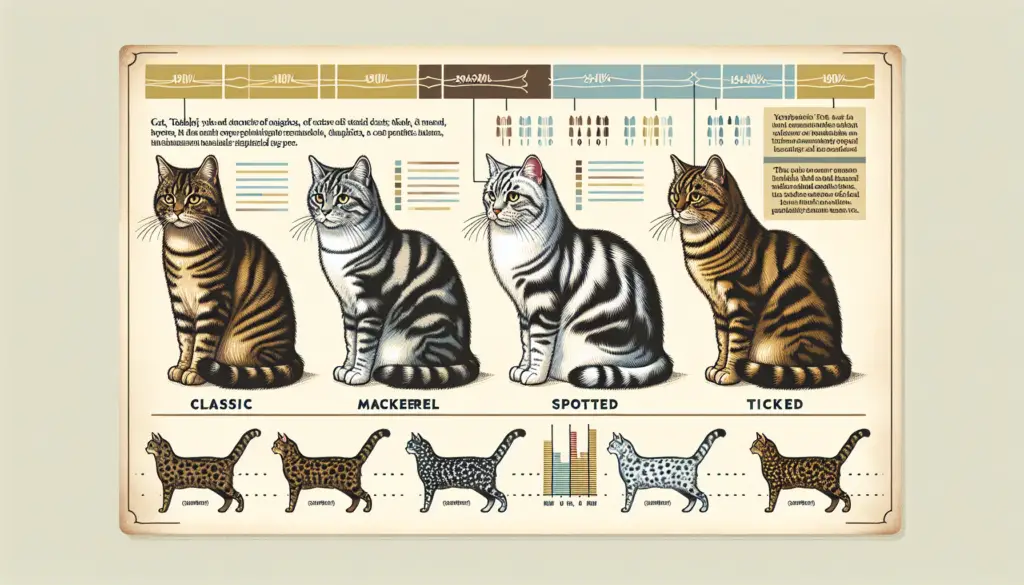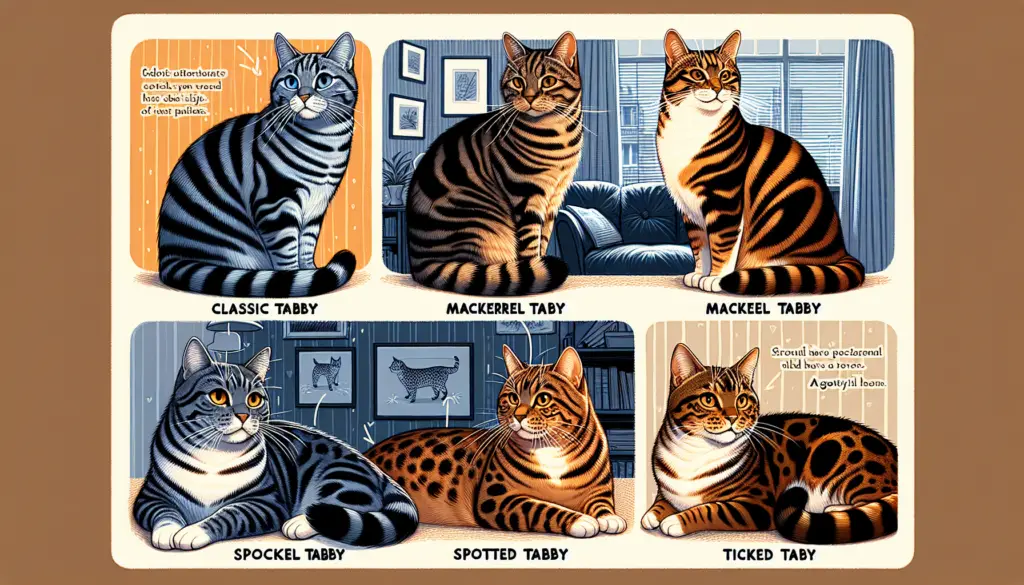Do you ever find yourself wondering about the different types of tabby cats? Well, look no further because this article will provide you with a comprehensive understanding of the classification of a tabby cat. From the classic striped pattern to the charming ticked coat, we will explore the various markings and colors that make each tabby cat unique. By the end of this article, you will be able to identify and appreciate the distinct features of these beloved feline companions. So, let’s dive into the captivating world of tabby cats together!
Physical Characteristics
Coat Patterns
Tabby cats are known for their distinctive coat patterns, which are a result of their genetic makeup. There are four main coat patterns found in tabby cats: mackerel, classic, spotted, and ticked. Each pattern adds to the unique beauty of these cats and showcases their individuality.
Eye Colors
Tabby cats can have a variety of eye colors, which further contribute to their overall charm. Common eye colors found in tabbies include green, gold, copper, and hazel. This wide range of eye colors adds to their captivating appearance and makes them even more alluring.
Body Size
When it comes to body size, tabby cats can fall into two categories: small/medium and medium/large. While their size may vary, tabbies possess a strong and sturdy physique, allowing them to be agile and active companions.
Body Shape
Tabby cats come in different body shapes, but they are generally known for their muscular and athletic build. Their bodies are well-proportioned, with a stocky frame that showcases their strength. These physical characteristics enable tabby cats to engage in various activities and excel in athleticism.
Genetic Basis
Agouti Gene
The agouti gene plays a crucial role in determining the coat pattern of a tabby cat. This gene is responsible for the tabby markings, whether it be mackerel, classic, spotted, or ticked. Through the agouti gene, the tabby pattern is expressed and gives these cats their distinct appearance.
Tabby Gene
The tabby gene, also known as the “T” gene, is the foundation of a tabby cat’s coat pattern. This gene is responsible for the markings on the cat’s fur, creating the unique patterns that tabbies are known for. It is the tabby gene that distinguishes tabby cats from other feline breeds.
Color and Pattern Genes
In addition to the agouti and tabby genes, several other genes contribute to the final appearance of a tabby cat. These color and pattern genes work together to determine the specific hues and variations in a tabby’s coat. The combination of these genes results in the wide array of coat colors and patterns seen among tabbies.

Coat Patterns
Mackerel Tabby
The mackerel tabby coat pattern is characterized by narrow, vertical stripes running along the cat’s body. These stripes resemble fishbones, hence the name “mackerel.” This pattern gives tabbies a sleek and elegant appearance, with the stripes usually extending from the neck to the tail.
Classic Tabby
The classic tabby coat pattern is characterized by bold, swirling patterns on the cat’s sides. Sometimes referred to as “blotched,” this pattern features large, solid-colored patches on the cat’s body, which contrast with the lighter background. The classic tabby pattern gives tabbies a sophisticated and regal look.
Spotted Tabby
The spotted tabby coat pattern is characterized by distinct spots scattered across the cat’s body. These spots can range in size and shape, creating a playful and whimsical appearance. Spotted tabbies have a striking resemblance to their wild ancestors, as their coat pattern resembles that of a leopard or cheetah.
Ticked Tabby
The ticked tabby coat pattern is unique among tabbies, as it doesn’t showcase bold stripes, swirls, or spots. Instead, tabbies with this pattern have individual hairs with alternating bands of color, creating a speckled or “agouti” effect. The ticked tabby pattern gives these cats a refined and subtle look.
Eye Colors
Green
Green is a common eye color found in tabby cats. It adds a touch of mystery and allure to their overall appearance. Tabbies with green eyes exude a sense of elegance and grace.
Gold
Gold is another eye color frequently seen in tabby cats. It is often associated with warmth and richness, adding a touch of luxury to their mesmerizing gaze. Tabbies with golden eyes have a captivating and enchanting allure.
Copper
Copper eyes are a unique and striking feature found in some tabby cats. They have a reddish-brown hue that emits an air of intensity and depth. Tabbies with copper eyes possess an alluring and soulful gaze.
Hazel
Hazel eyes are a blend of various colors, often combining shades of green, gold, and brown. This multifaceted eye color adds depth and complexity to a tabby cat’s appearance. Tabbies with hazel eyes have a captivating and ever-changing gaze.

Body Size
Small/Medium
Some tabby cats fall into the small to medium size range. These cats may have a delicate and petite build, but they are no less agile or energetic than their larger counterparts. Their size allows them to be nimble and gracefully navigate their surroundings.
Medium/Large
Other tabby cats fall into the medium to large size range. These cats possess a more substantial and muscular build, showcasing their strength and athleticism. Their size enables them to engage in physical activities with confidence and agility.
Body Shape
Muscular
Tabby cats are known for their muscular body shape. Their well-developed muscles give them the strength and agility needed to jump, climb, and explore. Tabbies with a muscular body shape have a solid and toned appearance, reflecting their active lifestyle.
Athletic
Along with being muscular, tabby cats have an athletic body shape. Their bodies are designed for agility and quick movements. Tabbies with an athletic body shape have a sleek and streamlined appearance, allowing them to excel in various physical activities.
Stocky
While most tabby cats have a more lean and defined physique, some may have a stockier body shape. These tabbies have a robust and sturdy build, with a broader frame. Their stocky body shape adds to their overall charm and showcases their strength.
Behavioral Traits
Temperament
Tabby cats are known for their delightful temperament and friendly nature. They often form strong bonds with their human companions and enjoy spending time with them. Tabbies have earned a reputation for being affectionate, independent, and intelligent.
Playfulness
Tabby cats are naturally playful and curious creatures. They have a zest for life and enjoy exploring their surroundings. They engage in interactive play and love chasing toys, climbing, and discovering new places. Tabbies’ playfulness adds a fun and lively element to their personality.
Social Skills
When it comes to social skills, tabby cats are generally friendly with people. They are often welcoming and enjoy being in the company of humans. Tabbies have a knack for adapting to various social situations and can be great companions to individuals and families alike. Additionally, they can exhibit compatibility with other pets, establishing harmonious relationships within a household.
In conclusion, tabby cats possess a wide range of physical characteristics, genetic traits, and behavioral tendencies. From their distinctive coat patterns to their captivating eye colors, tabbies are a delight to behold. Their body size and shape contribute to their agility and athleticism, allowing them to excel in various physical activities. Furthermore, their temperament, playfulness, and social skills make tabbies wonderful companions. Whether you are seeking a feline friend who is affectionate, independent, and intelligent, or one who exudes energy, curiosity, and friendliness, a tabby cat may just be the perfect addition to your life.

